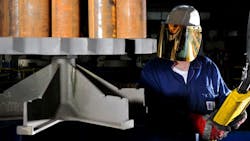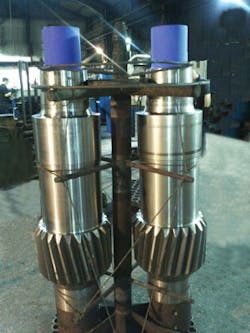Heat Treating is Getting to Be a Big Business
Developments in renewable energy, mining and quarrying, oil exploration, marine and other applications have led to significant increases in the size of power transmission components — like gears, shafts, pinions and bearings, to handle greater productivity demands. As these large components are exposed to severe duty cycles, there is renewed emphasis on the heat-treating methods needed to enhance their wear resistance and strength properties.
Estimated by industry sources to represent around 10% of component manufacturing costs, heat treatment modifies the microstructure of metallic materials, influencing mechanical characteristics like strength, ductility, toughness, hardness, and wear resistance. Thus, it increases the service life and technical performance of metal parts, which is even more critical for this new generation of larger components that are crucial to mechanical function and usually difficult to replace.
Anticipating growing customer demand for processing larger gears, shafts and other components, a commercial heat-treater that specializes in such products — Keighley Laboratories in West Yorkshire, England — recently expanded the holding capacity of one of its largest pit furnaces. By increasing the chamber’s dimensions to 1,110-mm working diameter and almost 1,800-mm maximum length, it gained over 30% in overall heat treating capacity. At the same time it carried out a capacity upgrade for the overhead crane that serves all seven pit furnaces on the site, as well as a salt bath and tempering equipment. The crane now has a maximum lift of 3.0-metric tons.
Enlarging the No. 1 pit furnace involved custom-fabricating an inner shell (or retort) made from duplex stainless steel, but this considerable investment has already been offset by some significant new orders: Keighley was contracted to heat treat 1,108-mm diameter gear wheels for an offshore project; and a 1,755-mm long, 1-mt shafts for a renewable energy project.
The company already has started to study upgrading other pit furnaces there, and its programmable process controllers, too.
“This has opened up a new market for us amongst engineering companies and OEMs, who are looking to heat treat larger components,” offered Michael Emmott, the commercial director. “This involves physical issues regarding accommodating the size of these parts, then lifting them out of the furnace and into the quench tank, as well as demanding special skills for treating very large workpieces without damage or distortion.”
Keighley Labs’ furnaces perform various heat-treating processes, including carburizing, carbonitriding, hardening and tempering, stress relieving, homogenizing and carbon restoration, working at temperatures up to 980°C. The operation handles steel, iron, high chrome iron, cast iron, ADI, and alloy steel materials. The products are used in numerous manufacturing sectors, including aerospace, marine, defense, rail, quarry and construction, energy, and general engineering companies.
Pit furnaces are vertically oriented batch furnaces, with the thermal-process section buried in a pit and extending up to floor level. A hydraulically operated, sealed cover extends above the surface. Workpieces are held in a jig or charge basket in the furnace, the inner retort protecting them from the direct radiation of heat. This configuration is particularly well suited to treating long parts, such as shafts, tubes and rods, although a wide variety of shapes and sizes can be accommodated, individually or in batches.
High repeatability, precise treatment
Apart from offering significant savings in floor space, with one sealed quench occupying the same floor area as four pit furnaces, furnaces like this offer very high repeatability, extremely precise thermochemical treatment, economic effectiveness, and the flexibility and capacity to treat both long components and large rounded parts, like gear wheels.
Pit furnaces also are known for producing minimal distortion, and this is particularly critical for larger components, where the same percentage of deformation equates to a much greater absolute distortion, possibly leading to the scrapping of parts.
Defined as irreversible and usually unpredictable dimensional changes during the process, distortion occurs when heating the workpiece above the transformation temperature results in it losing the inherent strength it possesses at room temperature, often causing it to distort under its own weight. Thus, long parts are preferably heated in a vertical pit furnace, to ensure that they are properly suspended during heating, while other parts must be carefully supported to suit their geometry, employing well-designed jigs and fixtures.
Keighley Labs has plenty of expertise in this area and its skilled furnace operators are responsible for jigging up the workpieces, uploading the computerized process routines into the furnace PLC, loading and unloading the workpieces, then transferring to the salt quench, before washing off the components and carrying out any subsequent tempering processes. Depending upon the required case depth, component geometry and specific customer requirements, heat treat cycles may last from two or three hours to two or three days.
“With our new heat treatment department, modern furnaces and advanced low temperature, low distortion, thermochemical processes coming on stream later this year, we wanted to renew the focus on our pit furnace capability, where we rank amongst the leaders in the contract heat-treat industry. When it comes to minimizing distortion in heat-treated components, pit furnaces still have a lot to offer and with gears, shafts and other parts increasing in size, minimizing the distortion is becoming an even greater challenge. It’s an area where we can usefully contribute, drawing upon our many years’ experience,” Emmott said.
“These days, many customers have highly technical resources and can specify unambiguously the heat treatment processes they require,” he added. “We are continually investing in our heat-treatment resources to keep abreast of their exacting requirements and offer alternative solutions across the whole spectrum of surface engineering. Where customers do seek our expertise, we are confident that we can provide in-depth practical and technical knowledge that is second to none,” he concluded.

